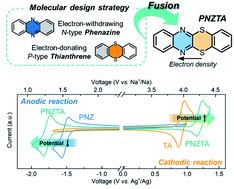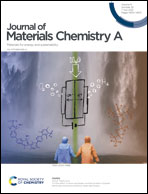A p–n fusion strategy to design bipolar organic materials for high-energy-density symmetric batteries†
Abstract
Development of a symmetric battery, which employs the same material as both anode and cathode, would significantly simplify the manufacturing process and reduce the production cost, and thus is regarded as a promising alternative approach. Nevertheless, (i) the difficulty in finding suitable bipolar-type active materials and (ii) the low voltage (typically lower than 2 V) from the reported bipolar materials have been the hurdles in its practical realization. Herein, we report a new molecular-level strategy of fusing appropriate p-type and n-type redox materials to develop bipolar-type materials. The inherent potential of each redox reaction in the fused structure is effectively shifted/separated due to the strong mutual electronic perturbation between two motifs, leading to higher voltages achievable in symmetric batteries. We showcase that newly designed PNZTA, a fusion of the phenazine and thianthrene redox centers, successfully manifests the bipolar redox activity and delivers a high discharge voltage of 2.33 V in a symmetric cell, one of the highest values reported thus far. This simple approach of fusion provides a new perspective in the design of high energy density bipolar redox materials and can be applied to a variety of combinations among p-type and n-type organic molecules in exploring high-energy-density symmetric battery chemistry.



 Please wait while we load your content...
Please wait while we load your content...